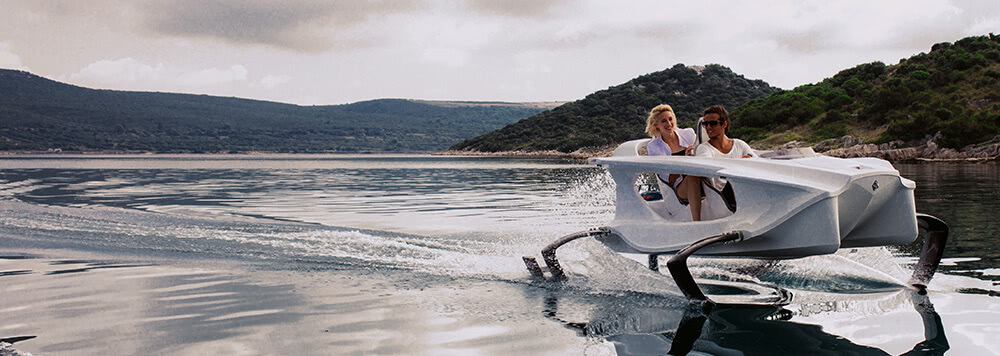This case study on Electric Powertrain Measurement on Hydrofoil was kindly provided by our supplier Dewesoft. For more information on their products or this application, contact us.
Electric Powertrain Measurement on Hydrofoil
Quadrofoil, Slovenia
The Quadrofoil Q2 has been characterised as an “ecologically-sound electric hydrofoil sports car for the water”. For a complex product such as this, it is necessary to continuously carry out extensive measurement procedures with test equipment. Dewesoft has helped Quadrofoil in measuring the performance of the electric powertrain of their prototype hydrofoil watercraft.
The Q2 is an advanced two-person electric watercraft which can reach speeds up to 40 km/h and has a turning radius of 7 metres. The Q2 watercraft has C-shaped hydrofoils – allowing an above-the-water and super silent flying experience.
Available in two models – Q2A Electric with a 3.7Kw outboard motor and Q2S Electric, consumers with the sportier 5.5Kw motor. Capable of a full recharge in three to four hours. The Q2A/Q2S Electric motors are managed by an intuitive Battery Management System (BMS) that monitors each cell’s performance.
About Quadrofoil
Slovenian business, Quadrofoil designed and manufactured the Q2. A hi-tech electrical engineering company with the mission to shape the future of the nautical industry and the way society embraces water transportation.
Hydrofoils let a boat go faster by getting the hull out of the water. When a normal boat moves forward, most of the energy expended goes into moving the water in front of the boat out of the way by pushing the hull through it. Hydrofoils can lift the hull out of the water so it only has to overcome the drag on the foils instead of all of the drag on the hull.
Testing Electric Powertrain Measurement in the Hydrofoil
Dewesoft set up the measurement of both the DC and the AC part of the Q2 powertrain to measure the efficiency and quality of power conversion of the brushless motor power inverter. Additionally, the position, velocity, acceleration, and orientation of the watercraft was measured using an inertial measurement unit (IMU) – an electronic device that measures and reports a body’s specific force and angular rate. Two cameras were used to monitor how much water the hydrofoils drew during operation.
Equipment used
The equipment used for the measurement was; a power supply unit (SIRIUSi-PWR-MCTS2), a data acquisition unit (SIRIUSi-HS-4xHV-4xLV), a battery pack (DS-BP2i), four current clamps (DS-CLAMP-500DCS), an inertial measurement unit (DS-IMU2), two cameras and a laptop running Dewesoft X3. This allowed gathering detailed data on the relation between power requirements and behaviour of the watercraft.
Firstly, the current clamps were mounted onto the power leads going from the battery to the power inverter. Also on the AC side of it, going to the motor. Because the space underneath the motor cover is really tight, the cover had to be completely removed and everything covered in a stretch wrap to protect the electronics from the water.
Then the IMU was mounted as close to the centre of the watercraft as possible. Also, the two accompanying GPS antennas to the rear and front ends of the watercraft. Firstly, one camera was placed on the side of the craft, looking at the left rear foil. Secondly, the second one high above the craft, fixed on a beam that was tied to the rear seat, providing a view of the front of the craft.
Battery pack, power supply for the current clamps, SIRIUS HS and a laptop was placed onto the rear seat. Once everything was connected, the unit was wrapped in plastic bags to provide protection from the water.
Finally, the Quadrofoil team put the craft into the water. Their test driver did a few shorter runs, setting up the foils into various different positions and making one long run in conclusion.
Analysis of Data
The data collected showed that the watercraft needs to reach approximately 10 – 12 km/h. So that it can rise out of the water and onto the hydrofoils. For which it requires about 13 to 14 kW of power. Reaching this stage, the power requirements drop to about 8 to 10 kW for cruising speeds between 24 – 30 km/h.
The efficiency of the power inverter was between 95 and 99 per cent throughout the whole measurement. A strong indication that the inverter is really efficient. Which again ensures that more energy is available for propulsion and that cooling requirements are low. Allowing for a more compact and lower cost cooling solution.
Quadrofoil aims to one of the leaders in e-mobility in the nautical industry. In future, the product range will include vessels for personal daily use. As well as for public and cargo transportation – all using eco-friendly hydrofoil technology.
